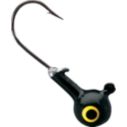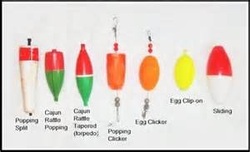A Little Chit-Chat

For our April 1st meeting, we invited Capt. Kyle Messier, with Florida Fishing Adventures, to come and speak to us on the topic of live bait vs artificial lures. He seemed excited to have been asked and accepted the invitation. We felt honored that he took the time to do so. He arrived a few minutes early to set up and struck up a conversation with Gloria, one our members who is a fly-fisher, about green-back cut-throat trout in Estes Park, Colorado. Capt. Messier told her that he visits a customer up in Colorado every year and fishes the Frying Pan and Roaring Fork Rivers just outside of Glenwood Springs targeting rainbow trout. Because he fishes saltwater on a daily basis, his down-time passion is rainbow and rook trout. Lucie jumped in the conversation at that point because she could relate to the adrenaline rush catching rook trout in Vermont, where she's from. While Gloria, Lucie and the Capt. were chatting about trout, a few other ladies asked Theresa how her husband, RG was doing. He had been in the hospital recently with back surgery but seemed to be recuperating okay.
Self Introduction

Now that most everyone had arrived and was seated, Capt. Messier made a brief self-introduction taking us back to his childhood when, "back in the day", he owned his first boat at age 12 and at age 14 got paid a quarter for every fish his customers caught. Since then, he's had the privilege to fish in some of the most exotic places in the world. He also mentioned that he was a certified fly fishing instructor (something that has been put on our activity agenda for the future). He went on to say that most Citrus Co. residence don't realize they live within just miles of the most dynamic fisheries found anywhere in the southern United States due to the seven spring-fed rivers that are constantly dumping into the Gulf of Mexico and encouraged us to explore them as often as we could. The months of April and May would be prime time to do so.
Let's Talk Fly-Fishing For Just A Moment....

Even though his main topic of discussion was live bait vs artificial lures, Kyle felt like it would be a disservice if he didn't include fly-fishing lures in the mix. "After all", he said, "Women are the fastest growing aspect of the sport of fly-fishing.", and he really encouraged us, as women, to give it a try - which we plan on doing at some point in the future. We would revisit this topic later in the evening.
What's Out There?

So Kyle begins with telling us that there are approximately 20 species of fish that are generally caught by inshore anglers in this area. Bait used should reflect the type of bait that's swimming in the waters at that time. Lures used should be an artificial representation of the same. Kyle showed us examples of a few of his favorites and explained why he likes them so much.
A Few Tips About Live Shrimp

Live shrimp is the number one bait of choice here on the coast, obviously because it's the most prevalent. Kyle's tip is that live shrimp will stay alive a lot longer (sometimes up to two days) on a piece of damp paper towel or newspaper over ice than they will in a live-well. Shrimp are held in temperature regulated tanks at most bait-&-tackle shops and a simple temperature change from cold water to warm water can eventually kill them. For instance, shrimp held in a 72 degree tank won't last long when they're transported into 85 degree live-well. This is handy information for those of us fishing from kayaks. Take one gallon capacity Igloo brand cooler, cover the bottom with ice or an ice pack, put a few pieces of newspaper on top of the ice, then lay your shrimp on top of the newspaper. This puts them in a dormant state but does not kill them. Other options for live bait are pinfish, white bait, needlefish, mullet. These are the baits that lure manufacturers strive to recreate.
When To Use Artificial Baits

Kyle suggested that artificial baits be used when scouting for fish. He gave us several reasons for this. For one - artificial baits (like Berkley's Gulp brand) is less expensive by comparison to live bait which can be depleted quickly by scavenger species like blue crab, pinfish and catfish, leaving you nothing to show for your $15.00 investment just hours before.. Because Gulp style baits are 'rubbery', they aren't as easy to pick apart and consume by smaller fish, which gives you more casts between hook checks and changes.
Invest in some 3" Berkley Gulp Shrimp in the color of New Penny.
He also mentioned that shrimp molt around moon phases and Berkley also makes a molting color which should be used when fishing around the new moon and/or full moon phases.
Invest in some 3" Berkley Gulp Shrimp in the color of New Penny.
He also mentioned that shrimp molt around moon phases and Berkley also makes a molting color which should be used when fishing around the new moon and/or full moon phases.

This bait can be rigged all different ways, but Kyle's favorite is this:
A standard 1/4 oz jig-head (no preference on color or mfg - whichever is the cheapest because, theoretically, they all work the same). Jig-heads are really nothing more than pre-weighted hooks with the weight being painted in various colors and "eyes" in a contrasting color.
A standard 1/4 oz jig-head (no preference on color or mfg - whichever is the cheapest because, theoretically, they all work the same). Jig-heads are really nothing more than pre-weighted hooks with the weight being painted in various colors and "eyes" in a contrasting color.

Then he pulled a dead shrimp out of a small Zip-lock baggie and pointed out the small dark spot on top of it's head which is considered its brain. Avoid threading a hook through that part of the shrimp unless you want to cause instant death, because that's exactly what will happen. Every other part of that shrimp is fair game. What you're looking for is the shrimp to make its natural flicking action with its tail - that's how it propels itself through the water, making slight vibrations in the water which attract predatory fish.

Kyle taught us that pinching off the shrimp's tail is another trick he always uses because it releases scent into the water. He demonstrated exactly what he was talking about by threading the hook through its tail as in the picture to the left. There are so many different ways you can use this rig. For instance...you can cast it out and just let it sit on the bottom (for redfish or founder), you can slowly retrieve it like you would an artificial bait (for trout or jacks) or you can put an adjustable bobber on the line to cover various depths. With a bobber, you can actually 'troll' this behind the kayak as you slowly paddle. It's very basic, but very effective. Or you can toss it in the water, leave your reel bail open for a short time and let just drift into a certain spot you may have paddled past (depending on the current direction, of course). Then simply take the bobber off if you want to fish the bottom for a while.

Another way to thread a shrimp on a jig-head for fishing in a strong current or fishing for sheepshead is to run the hook close to the shrimp's horn (avoiding the brain, remember), Let it sink to the bottom at which time the scent will travel in the current alerting larger fish that 'something delicious cometh this way'. They'll take the initiative to come and check it out. The hook in the horn area is because most fish will grab a shrimp or other bait fish by the head first. For this reason, some researchers theorize that the big black spot at the tail of a redfish is its way of tricking a shark or dolphin into thinking it's an 'eye' instead of a tail - allowing for a quick escape.
Another Artificial Bait

Like the Berkley brand, DOA is another company that manufactures artificial shrimp in a gazillion colors. The difference is that Berkley Gulp shrimp are marinated in a patented nasty smelling hormone scented liquid that attracts fish. DOA shrimp aren't scented that way but are sold with a hook and weight built in. In addition to being a bit less expensive, they are also a bit more durable than the Gulp. A Gulp shrimp is like a sponge, if it is left on a jig-head and open to the elements too long, it will shrivel and harden to the point that you may not be able to salvage your jig-head at all. But both Gulp and DOA shrimp can be used independently or tied off to a popping cork. Some DOA shrimp are actually sold already rigged to a popping cork. The colors of glow and gold work best according to Kyle.
Speaking of Popping Corks...

If you fish anywhere in and/or near Homosassa, Crystal River and Yankeetown, the popping cork is a staple on any boat or kayak. The cork itself does nothing to attract fish until you use it as it was designed to be used - popping it (hence the name 'popping' cork). When the angler makes several short but strong tugs on the rod, the beads on both sides of the cork makes a popping sound which attracts curious fish to your artificial bait. The hope is that those fish literally 'take-the-bait'. The cigar bobber is Kyle's favorite but on windy days, he uses a bigger cork that's a little easier to spot in a pinch. On occasion he'll use a snap swivel to connect a treble hook to the bottom of the popping cork because trout will attack the cork itself when popped instead of the bait he had on a hook several feet below. The challenge is getting the fish's attention off of the cork and its focus on to the bait.
Also - smash the hook barbs down on a treble hook....really makes dehooking a lot easier!!
You can use a Gulp shrimp on a weighted jig-head for a faster sinking bait with a popping cork (which isn't always the best choice) or you can use a lighter, slower sinking DOA shrimp (it has air injected into it), as bait with a popping cork. Just make sure your cork isn't the main attraction - your bait should be!
Also - smash the hook barbs down on a treble hook....really makes dehooking a lot easier!!
You can use a Gulp shrimp on a weighted jig-head for a faster sinking bait with a popping cork (which isn't always the best choice) or you can use a lighter, slower sinking DOA shrimp (it has air injected into it), as bait with a popping cork. Just make sure your cork isn't the main attraction - your bait should be!
It's The Company You Keep

Capt. Messier changed topics for a few minutes and gave us a little insight on how fish congregate. You can usually find trout hanging out with schools of ladyfish and similarly, you can sometimes find redfish swimming with schools of mullet looking to eat the small and injured if given the opportunity. Another reason you can find reds with mullet is that large schools of mullet will stir up the bottom exposing small grabs and shrimp for redfish to find. If you're targeting redfish, look for jumping mullet and paddle there. The trout mass with ladyfish because they are both baitfish eaters. They sometimes work together to target baitfish. Also, when dolphin come to call for dinner, trout can sometimes escape the danger because the ladyfish are so much more abundant which makes them easier targets for the dolphin.






 RSS Feed
RSS Feed